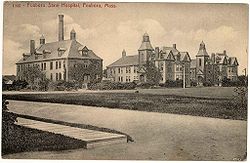Foxboro State Hospital
| Foxboro State Hospital | |
|---|---|
 Foxboro State Hospital | |
| Construction Began | 1889 |
| Current Status | Preserved |
| Building Style | Pavilion Plan |
| Architect(s) | Charles Brigham |
| Alternate Names |
|
History[edit]
The Massachusetts Hospital for Dipsomaniacs and Inebriates was designed by architect Charles Brigham, and opened in 1889 to treat alcoholics. In 1905 the hospital began to treat psychiatric disorders, and by 1910 it was solely a psychiatric institution, and became known as Foxboro (or Foxborough) State Hospital. The hospital ceased most of it's operations in 1976, but the buildings have been used for other purposes such as file storage and haunted houses during the Halloween season. The layout of this institution was very unique; the original inebriate asylum consisted of a few isolated buildings that were later connected by very long hallways, which served as day rooms. Patient rooms were in wings that branched off to the sides, and the newest additions (circa 1950's) were dormitories that were covered in tile. Many cupolas adorn the roof, and the basement holds a surprisingly large eight body morgue. There are two cemeteries nearby holding around 1,100 patients with headstones marked with only a patient number and a grave number.
The Foxboro State Hospital closed in 1976, however many parts of the building were put to re-use by various government entities. The hospital's Theatre was also home to the Foxboro Jaycee's haunted house one year. In 2004 the property was sold to a developer and early constrction began, and early in 2006 the buildings were almost completely prepared for either demolition or restoration. In July, 2006 a four-alarm fire ripped through a ward of the main hospital building. The fire was mostly contained to that one ward. By 2009 a large portion of the older buildings had been converted to condominiums & office space.
Images of Foxboro State Hospital[edit]
Main Image Gallery: Foxboro State Hospital
Cemetery[edit]
There are two cemeteries for Foxboro State Hospital and they are not on the grounds. The cemeteries are about an 1/8 of a mile from the hospital on Cross Street. One is close to the road and the other is about 125 yards up into the woods. The names and corresponding grave numbers have been lost. There may be 1,100 former DMH clients buried in the two cemeteries. When researching these cemeteries Pat Deegan noticed that each marker has two sets of numbers. The first list the order in which the burial took place. The second number, on the back of the stone, seems to be a patient identification number. It would be relatively easy to reconstruct a list of who is buried based on these numbers. A group would have to get special permission from the state to match numbers with names but once that was done, a complete list could be reconstructed.

